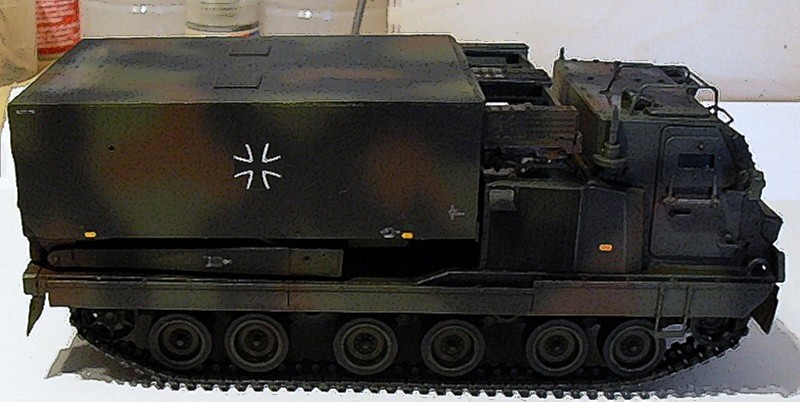Impression issue de Maquetland.com Le monde de la maquette | http://www.maquetland.com/article-phototheque/111-lrm-m-270-france
 LRM M 270 France
LRM M 270 France

Le LRM (Lance Roquette Multiple)M 270 The MLRS (Multiple Launch Rocket) M 270
English Translation
 |
| Sigle Vought |
Les occidentaux dans l'immédiat après-guerre n'ont pas développé sur une grande échelle des systèmes appelés communément orgues de Staline alors que leurs adversaires potentiels du Pacte de Varsovie ont développé ce type d'armes sur une grande échelle. Seuls les allemands ont construit un matériel le LARS (Light Artillery Rocket System) de calibre 110 et le prototype français Rafale développé en 1970 est resté au stade des études ou de la construction de matériel de démonstration. Il faut attendre le milieu des années 70 pour voir les états-majors occidentaux les Américains en tête de commencer à s'intéresser à ce type d'armes.
Ainsi est né de L. R. M. en France et MLRS Multi Lance Rocket système en anglais qui avait été au début appelé G. S. R. S. Général Support Rocket Système. Ce type d'armes suppléé l'artillerie classique pour délivrer en profondeur des salves d'artillerie sur une surface importante. Ainsi ce matériel peut fournir un excellent tir contrebatterie il contribue à frapper loin derrière la ligne de front des concentrations des troupe ou de Matériel The Western Allied in the immediate post-war period have not developed on a large scale systems commonly known as Stalin's organs while their potential adversaries of the Warsaw Pact have developed such weapons on a large scale. Only the Germans had built the LARS (Light Artillery Rocket System) class 110 and french Rafale prototype developed in 1970 remained in the study phase and construction equipment demonstration. It was not until the mid-70th to see Western HQ leads the Americans to begin to take an interest in such weapons.
Thus was born of MLRS Multi Rocket System, which had been called at the beginning G. S. R. S. General Support Rocket System. This type of weapons supplied artillery classical to deliver in-depth bursts of artillery over a significant area. So this material could provide an excellent shooting contrebatterie it contributes to strike far behind the front line concentrations of troops or equipment
Historique.
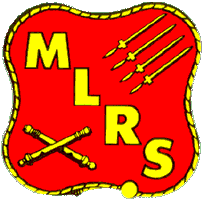
Le 12 décembre 19715 la première fiche technique du matériel appelé G. S. R. S. est envoyé aux industriels. Le choix de société en compétition est établie en mars 1976 avec le choix de Boeing, Vougth, Martin Marietta, Emerson Electric et Northtop Le 14 juillet 1976 la fiche programme est enfin finalisée. Le 14 février 1977. premières modifications du programme notamment la possibilité de pouvoir tirer divers types de munitions des mines entre autres
Le19 septembre 1977 Boeing et Vougth sont sélectionnés pour donner vie au programme. L'année 1977 voit aussi le premier tir du missile le 5 décembre suivi le14 avril 1978 par le premier tir à partir de container Le 26 mars 1979 à lieu le premier tir d'une tête de guerre chimique suivit le 30 mars 1979 du tir d'une salve complète. Entre-temps les négociations vont bon train et en Juillet 1979 un accord est trouvé avec les partenaires européens pour la construction de ce type d'arme en Europe la France dans le Royaume Uni et l'Allemagne de l'Ouest signent un projet de coopération militaire Le 25 Juillet1979 l'Italie s'associe elle aussi au programme.
Le 16 décembre 1979 le terme MLRS se substitue au terme G. S. R. S. afin de standardiser l'appellation et les alliés européens. Le 29 avril 1980 la société Vough gagne la compétition et est désignée maître d'oeuvre du programme. Le 23 juillet 1980 la signature officielle avec les différents gouvernements européens a lieu
. Le 12 février 1982 une salve complète est tirée avec succès à partir du châssis.
. Et le 31 mars 1982 la première batterie de l'armée américaine est déclarée opérationnelle à Fort Riley dans le Kansas
Le 1er septembre 1989. voit le premier déploiement en Europe au sein de la 8° DI US alors que la 2° DI US en Corée est équipée en juin 1984. Le 29 11 1984a lieu la signature officielle avec les partenaires européens a lieu la production aura lieu au sein d'un consortium qui regroupe pour les USA Martin Marietta, pour les français Thomson Brandt pour les Anglais Thorn EMI et pour les Allemands Diehl Gmbh.
Le 31 janvier 1985 c'est au tour de la 3° DI US d'être équipée en matériel neuf. La fin de l'année 1985 voit toutes les unités américaines stationnées en Europe équipées de ce matériel. En 1987 la Turquie est autorisée à fabriquer ce matériel et en 1988 c'est au tour de la Garde Nationale d'Oklahoma d'en être équipée alors que dans le même temps la production industrielle débute en Europe en novembre 1988.
Le 13 février 1991 a lieu du premier tir opérationnel de cette arme lors de l'opération Désert Storm.
Entre 1991 et 1994 les partenaires européens s'équipent de ce matériel. Ce matériel équipe désormais 14 armées pour un total de plus de1450 systèmes d?armes et il est sans cesse mis à niveau
En 1994 les systèmes commandés étaient de 67 pour les anglais 56 pour les français 202 pour les Allemands 20 pour les Italiens
History.
On December 12th 1971 the first detailed technical material called G. S. R. S. Is sent to manufacturers. The choice of competing society is established in March 1976 with the choice of Boeing, Vougth, Martin Marietta, Emerson Electric and Northtop On July 14th 1976 the detailed programme is finally completed. On February 14th 1977. First amendment of the program includes the opportunity to be able to draw various types of ammunition among other mines
On September 19th 1977 Boeing and Vougth are selected to give life to the program. The year 1977 also saw the first launch of the missile on December 5th followed on April 14th 1978 by the first shot from the container and on March 26th 1979 to place the first launch of a head of chemical warfare followed on March 30th 1979 by the shooting of a full salvo. In the meantime negotiations are going well and in July 1979 an agreement is reached with European partners for the construction of this type of weapon in Europe
France UK and West Germany sign a cooperation project On July 1979 Italy also endorsed the program.
On December 16th 1979 the term MLRS replaces the term G. S. R. S. . On April 29th 1980 the company Vough wins the competition and is designated contractor for the program. On July 23rd 1980 the official signing with the various European governments takes place
On February 12th 1982 a salvo complete successfully is pulled from the chassis.
And finaly on March 31st 1982 the first battery of the American army was declared operational at Fort Riley in Kansas
On September 1st 1984 see the first deployment in Europe with US DI 8th as the DI US 22nd in Korea is equipped in June 1984. On November 29th 1984 see the official signing with European partners (consortium that includes the USA for Martin Marietta for french Thomson Brandt for English and Thorn EMI for the Germans Diehl Gmbh. )
On January 31st 1985 it was the turn of the 3rd US DI to be equipped with new equipment. The end of 1985 saw all the units stationed in Europe equipped with such equipment. In 1987 Turkey is authorized to manufacture this equipment and in 1988 it was the turn of the National Guard Oklahoma to be fitted while at the same time, industrial production began in Europe in November 1988.
On February 13th 1991 held the first operational firing of the weapon during Operation Desert Storm.
Between 1991 and 1994 European partners equipped with such equipment. This material team now armed 14 for a total of over de1450 weapons systems, and is continually upgraded
In 1994 ordered the systems were 67 for English 56 for French 202 for the Germans 20 for Italians
Le Système d'armes M 270 MLRS ou SPLL (Self Propelled Loader Launcher)

Le M270 est construit sur un châssis dérivé du M2 /M3 Bradley mais plus long. Il conserve toutefois 80 % des éléments communs au VCI ; Le M270 est le mariage des M993 et du M269
Il se présente comme un châssis chenillé avec un train de roulement chenillé à 6 galets de route et 2 galets de supports situées au centre du châssis (M993) Le barbotin se trouve à l avant et la roue tendeuse à l?arrière. La version allemande MARS est un peu différente aux niveaux des chenilles Ce châssis chenillé supporte 2 éléments une cabine à l avant et un plateau à l'arrière sur lequel est posé un gros container . La cabine blindée pressurisée (protection NBC) abrite l'équipage de l engin qui est au nombre de 3. Le pilote à gauche le chef de pièce à droite et le tireur au centre. Cette cabine est protégée par des volets blindés qui obturent le pare brise lors du tir. Elle possède 2 portes latérales. A l'arrière de cette cabine se trouve un gros coffre qui sert de rangement.
Le plateau arrière supporte le système d arme qui est contenu dans un gros container (M269) rectangulaire. Les roquettes dans l'armement classique sont placées donc 2 containers d'une capacité de 6 roquettes rangées en 2x3. Le container peut être levé en site et orienté en azimut par un système de vérins hydrauliques
Le M 270 peut se déplacer à une vitesse de 64 km/h passe un obstacle vertical de 1 m et franchir un devers de 60 ° il possède une autonomie de 435 Kms
Dans l' armée américaine nous trouvons 29 MLRS par Bataillons. Il est aérotransportable par C5 et C17.
En décembre 2000 la firme Martin Marietta reçoit un contrat pour moderniser 66 lanceurs M270 qui vont être désignés M270 A1. Ces M270 A1 seront livrés en 2004. La modernisation porte sur le contrôle de tir et le système de Lancement. La Corée du Sud commande ce matériel. Ce système développé par Lockheed Martin équipe en plus de la Corée et des Usa les Anglais
Par contre les Italiens, les Allemands et les Français reçoivent un système de conduite de tir mis au point par EADS/Dornier
The Weapon Systems M 270 SPLL or MLRS (Self Propelled Loader Launcher)
The M270 is built on a chassis derived from the M2 / M3 Bradley but longer. It retains 80% of the common elements in APC The M270 is the marriage of M993 and M269
It has a tracked chassis with a rolling gear with 6 tracked roller drive and 2 rollers at the heart of the chassis (M993) The sprocket is at the front
The German version MARS is a little different at the levels caterpillars This chassis supports tracked 2 elements to a cabin before and a plateau the rear on which is placed a large container. The armored cabin pressurized (protection NRBC) features the crew of the device (3 mens). The pilot left the cheif of vehicle on the right and the gunner in the center. This cabin is protected by armoured shutters who are closed during the shooting. It has 2 doors. At the back of this cabin is a big box serves as storage.
The rear shelf supports weapon system t(large rectangular container (M269)) The rockets for a conventional armaments are therefore placed 2 containers with a capacity of 6 rockets into 2x3 rows. The container can be lifted oriented site and azimuth by a hydraulic system ( jacks)
The M 270 can move at a speed of 64 km / h cross an obstacle to 1 m vertical a downhill 60 ° it has an range of 435 Kms
In the American army we find 29 MLRS /battalions. It is air transportable by C5 and C17.
In December 2000 the firm Martin Marietta received a contract to modernize 66 launchers M270, which will be designated M270 A1. The M270 A1 will be delivered in 2004. The modernization covers the fire control system and the launch. South Korea ordering the equipment. The system developed by Lockheed Martin team equip Korea Great Britain and Usa
By contrast the Italians, Germans and French receive a Fire Control System developed by EADS / Dornier
La Munition M26
L armement principal du MRLS est constitué par une roquette de 227 mm sans guidage stabilisée par 4 ailerons qui envoie à 30 kilomètres 644 munitions M 77
Ce qui veut dire qu'une salve complète envoie sur un objectif 8000 munitions en 60 secondes
Pour vous situer une salve nettoie l'équivalent d'un terrain de foot .Le container (LP/C Launch Pod Container) contient 6 roquettes et le M269 en emporte 2
Pour l Armée américaine le ravitaillement est apporté par des camions tactiques Oshkosh HEMTT (Expanded Mobility Tactical Trucks) attelés à une remorque HEMAT (Heavy expanded Mobility Ammunition Trailer) soit 8 recharges par chargementThe M26 Munition
MRLS main armament consists of a 227 mm rocket stabilized by without guidance fins that sends 4 to 30 km 644 ammunition M 77
This means that a full salvo sent on a target 8000 ammunition in 60 seconds
A salvo cleans the equivalent of a football field. Container (LP / C Pod Launch Container) contains 6 rockets and M269 transport 2 containers
For US Army resupply is provided by tactics trucks Oshkosh HEMTT (Expanded Mobility Tactical Trucks) coupled to a trailer HEMAT (Heavy expanded Mobility Ammunition Trailer) 8 refills by loading
Variantes
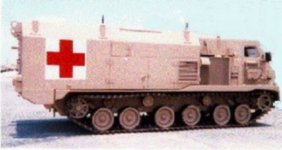
AMTV (Armored Medical Treatment Vehicle) Version ambulance
Ce véhicule possède en lieu et place du LP/C avec les roquettes, un container abritant une ambulance de campagne vaste et bien équipée. Il est a même de secourir en premier ligne des blessés graves AMTV (Medical Treatment Armored Vehicle) Version ambulance
This vehicle has instead of the LP / C with rockets, a container housing a vast ambulance and well-equipped. It is even assist in the first line the serious injuries

HIMAR (High Mobility Artillery Rocket System)
C'est le dernier né de la gamme MLRS il possède le système M269 (LP/C) mais avec seulement 6 roquettes sur un châssis à Roues de la marque Steward and Stevenson dans le Texas L'USMC et l' US Amy l'ont commandé à 900 exemplaires En 2004 3 prototypes ont été envoyés en Irak pour essais réels sur le terrain. En juin 2005 le 27 th Field artillery du 18th Air Borne Corps ont reçu ces matériels. Il est aérotransportable par C130 lorsque les C141 ou c5 ne peuvent atterrir. Il tire les mêmes munitions que le MLRS et pourra tirer toutes les autres munitions prévues
HIMAR (High Mobility Artillery Rocket System)
It is the newest of the range it has the MLRS M269 system (LP / C) but with only 6 rockets on wheeled chassis of the mark Steward and Stevenson in the Texas The USMC and the US have Amy ordered 900 vehicles
In 2004 3 prototypes have been sent to Iraq to real testing ground. In June 2005 the 27th Field artillery of the 18th Air Borne Corps received its equipment. It is air transportable by C130 or C141 where the C5 cannot land. It draws the same ammunition that the MLRS and will draw all the other ammunition planned
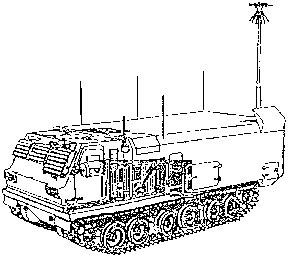
Le M4 Command and Control Vehicle (C2V)
Le C2V doit remplacer l'actuel véhicule de commandement M577A2. Il sera construit sur châssis modifié de M993 (MLRS) châssis, avec les mêmes caractéristiques que le véhicule de base. Le C2 V sera protégé NBC ainsi que contre les agressions électromagnétiques. Il résiste aux impacts de balles de 7.62mm tirées à 200 m, et contre le souffle des obus de 155mm HE explosant a 30 mètres
Le C2V est apte à commander un état major au niveau bataillon et il possède la même mobilité que les Abrams et Bradley Fighting Vehicle (BFV). Les personnel peut travailler même lorsque le véhicule se déplace Le C2V abrite le Army Battle Command System (ABCS) Common Hardware and Software (CHS),Le C2V profite des acquits technologiques développés pour le M1068 Standard Integrated Command Post System ( variante du M577)
The M4 Command and Control Vehicle (C2V)
The C2V should replace the current command vehicle M577A2. It will be built on the chassis modified M993 (MLRS) chassis, with the same characteristics as the base vehicle. The C2 V will be protected NRBC as well as against electromagnetic attack. It withstands impacts of 7.62mm bullets fired at 200 meters, and the blast shells exploding 155mm HE was 30 meters
The C2V is fit to order a major state-level battalion and he has the same mobility as the Abrams and Bradley Fighting Vehicle (BFV). The staff can work even when the vehicle is moving The C2V home to the Army Battle Command System (ABCS) Common Hardware and Software (CHS), The C2V technological benefits scheme developed for the M1068 Standard Integrated Command Post System (variant of the M577)
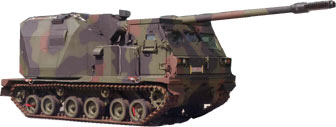
L'AGM Artillery Gun Module
Développé en Allemagne par KMW ce système propose l?adaptation d?une pièce de 155 développé pour le Pzh2000 sur un châssis renforcé du MLRS .La pièce de 155 peut être remplacée par un tube de 105 mm.
The AGM Artillery Gun Module
Developed in Germany by KMW
It is the adaptation on the chassis of a 155mm gun developed for the Pzh2000 on a reinforced chassis of MLRS.155mm may be replaced by a tube of 105 mm.
Le LRM en Europe The MRLS in Europe
Armée française French Army

Brigade d'Artillerie Artillery Brigade
Les LRM de l'Armée francaise sont tous regroupés dans la Brigade d'Artillerie qui fut créée le 1 juillet 1998 par la fusion de la 3°Brigade d'artillerie du 3° CA et de la 19 Brigade d?Artillerie de la FAR. Cette unités regroupes en sont sein tous les régiments de défense SA et d appui feu de l'Armée à savoir les 1° 12° 57 ° RA bases a Haguenau Belfort et Bitche ainsi que les 54° RAA et 402 Ra de Hyères et Chalon en Champagne
TheMRLS in France are all grouped together in artillery Brigade, which was founded on July 1st 1998 through the merger of the 3rd Brigade artillery of 3rd CA and the 19th Brigade d’Artillerie of FAR. The units are grouped within all regiments ground Air defence and fire support of the Army namely 1st 12th ° 57th RA has bases and Bitche Haguenau Belfort and the 54th and 402nd RAA in Chalon Champagne and Hyères


Les régiments équipés de LRM sont donc le 1° RA (crée en 1637) et le 12° RA créé en 1837
Ils possèdent 3 batteries de tir avec 24 LRM ainsi qu?une Batterie de Mortiers de 120 mm
L'EAAA de Draguignan elle aussi met en oeuvre le LRM
Les LRM français sont ravitaillés par les véhicules RVI TRM 10 000
The regiments equipped with MRLS are the 1st RA (founded in 1637) and 12th RA created in 1837
They have 3 batteries with 24 MLRS and a 120 mm mortars battery
The EAAA Draguignan also implements the MRLS
The RSM french are fuelled by vehicles RVI TRM 10000
Esercito Italiano Esercito Italiano
Un seul régiment est équipé de LRM c'est le 5° Regimento d'artillieria pesante « Superga » (créé en 1850 ) et stationné Udine
One regiment is equipped with MRLS is 5th Regimento d artillieria pesante Superga (created in 1850) and barracked in Udine
L'Ecole d application de l'Arme basée à Bracciano met en oeuvre elle aussi ce matériel
The School of application of Arme based in Bracciano implements also this material
British Army British Army
L'Ecole d Application de l Arme est basé à Larkhill près de Salisbury
Les LRM sont mis en ouvre dans divers régiments
Le 39 ° Royal Artillery Regiment avec :
La 132 Battery (Bengal Rocket troop) batterie créée en 1816 aux Indes
La 176 Battery créée en 1860 au Soudan
Le 101° Royal artillery Régiment avec
La 203° Battery créée en 1900 pour combattre les Boers
La 205 ° Battery créée en 1859 comme faisant parti de la Territorial Army
The School of Application of the weapon is based at Larkhill near Salisbury
TheMRLS are implemented in various regiments
The 39th Royal Artillery Regiment with:
The 132 th created in 1816 in India with Bangalore rockets
The 176th created in 1860 in Sudan
The 101st Royal Regiment with artillery
The 203rd created 1900 for fighting Boers
The 205th cretred in 1859 as part of the Territorial Army
Bundeswehr Bundeswehr

Ecole d artillerie School artillery
Le MRLS est en dotation à l'École d'Application de l'Artillerie d'Idar Oberstein
Brigade Franco Allemande au sein du 295° Art Btl à Immedingen
1 Pz Div au sein du 132°Art Bataillon
122 Art Btl à Hermeskiel
Les MRLS Allemands sont ravitaillés par les camions tactiques allemands de la gamme MAN
The MRLS is staffing at the School of Application of Artillery of Idar Oberstein
Franco German Brigade in the 295th Art Btl to Immedingen
1st Pz Div 132nd Art Battalion
122nd Art Btl to Hermeskiel
The MRLS Germans are fuelled by the German tactical trucks in the range MAN
Caractéristiques
Constructeur Vough
Poids 25 T
Equipage 3
Longueur 7.167m
Largeur 2.57 m
Hauteur 2.57 m déployé 5.92 m
Moteur
Autonomie 450 Kms
Vitesse 64 Kms/h
Armement
De base 12 roquettes de 227 mm temps de rechargement 9 minutes
Portée 30 Kms
tECHNICAL SPECIFICATIONS
Manufacturer Vough
Weight T 25
Crew 3
Length 7.167m
Width 2.57 m
Height 2.57 m 5.92 m deployed
Engine
Autonomy 450 Kms
Speed 64 km / h
Weaponry
From 12 base 227 mm rockets time reloading 9 minutes
Range 30 Kms



